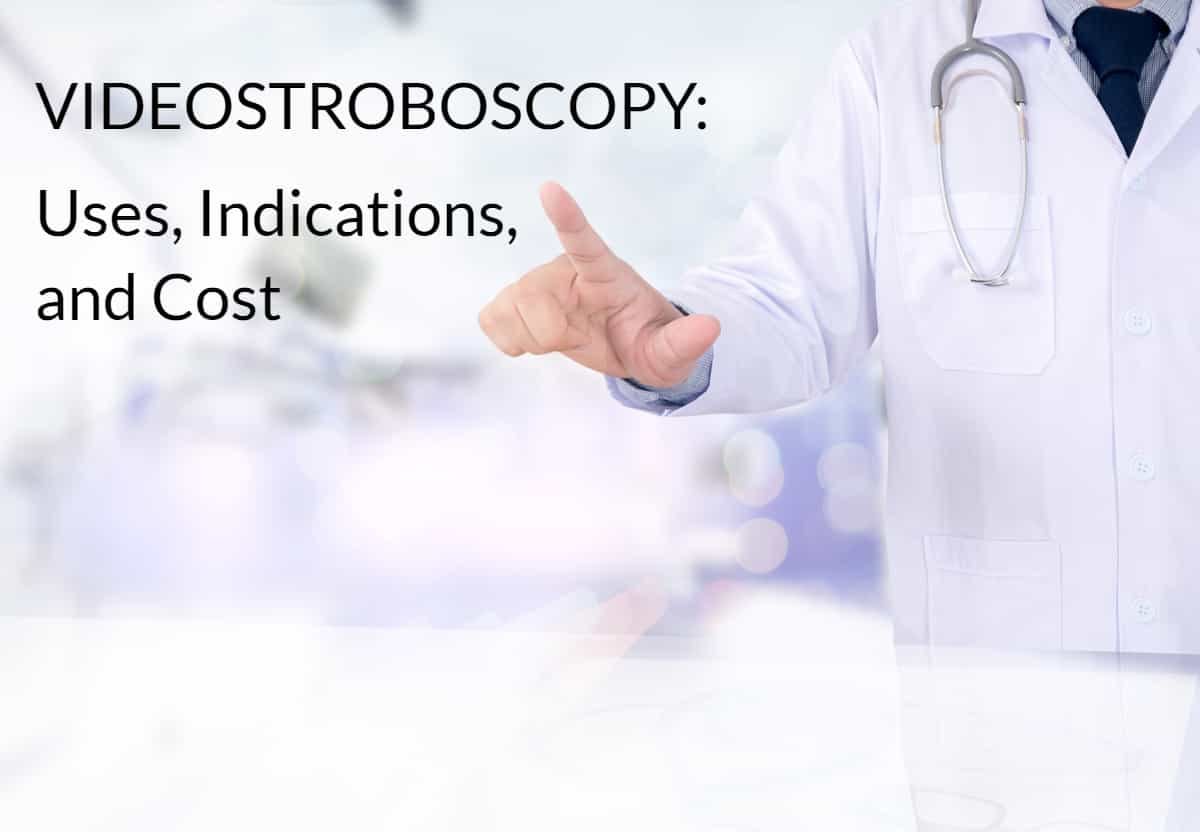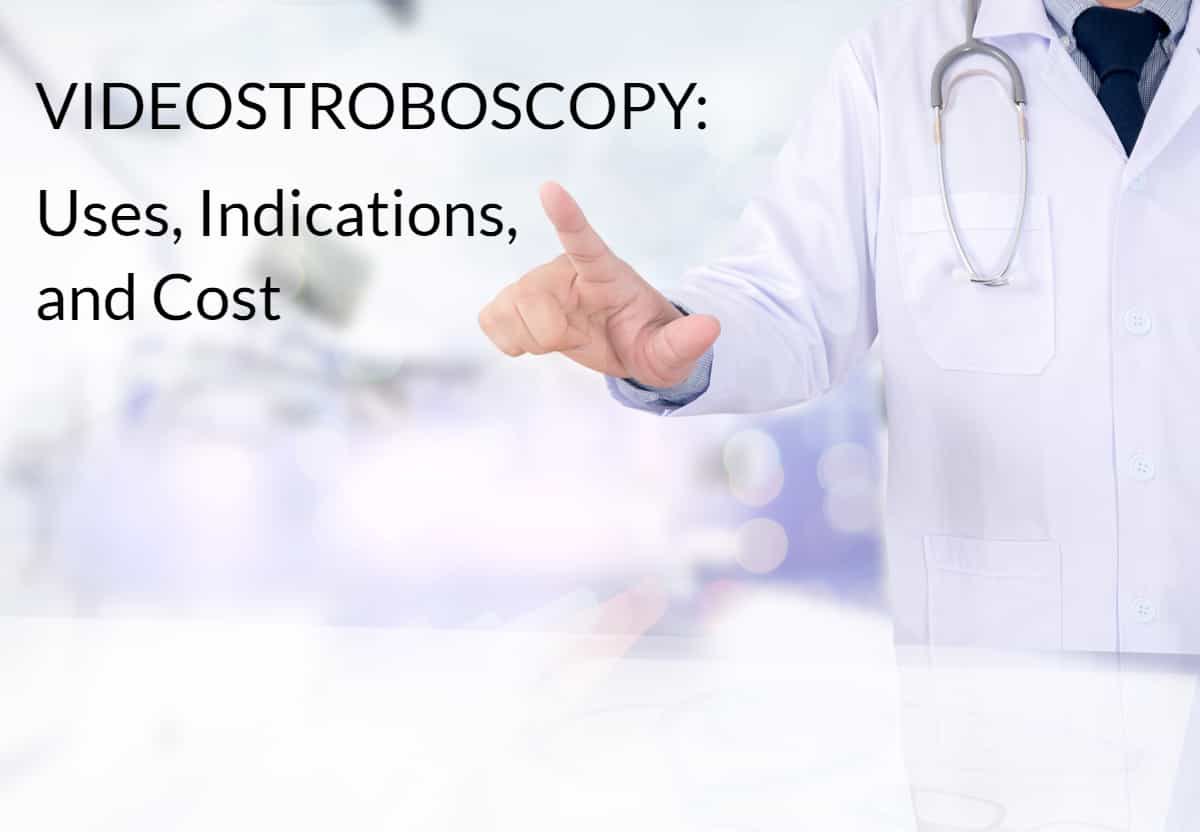What is a Videostroboscopy Procedure? (Uses, Indications, and Cost)
October 11th, 2019 | 4 min. read


Ear, Nose and Throat (ENT) specialists provide state-of-the-art technology to diagnose and treat voice disorders. One essential tool they use in the evaluation process is videostroboscopy.
What Is a Videostroboscopy Procedure?
A videostroboscopy procedure is a non-invasive exam of your larynx. It's thought to be the gold standard in laryngeal examinations. There are various reasons why you'd be referred for this procedure, including if you're experiencing:
-
Persistent laryngitis
-
Vocal cord dysfunction
-
A foreign or globus body sensation
-
Other vocal complaints
Videostroboscopy Definition
The videostroboscopy procedure is a state-of-the-art procedure that provides the doctor with a slow-motion, magnified view of your vocal cords in action. It enables a team approach where the doctor and a speech-language pathologist can evaluate a number of vocal parameters and view irregular motion and other conditions of the vocal folds. They also make judgements regarding the neighboring tissues and muscles in the larynx.
Uses of Videostroboscopy
There are various uses of videostroboscopy, including:
-
To determine the cause of voice dysfunction or hoarseness that might be due to vocal cord swelling because of heavy use, irritations, misuse, growths, polyps or acid reflux
-
To visualize your vocal cords
-
To evaluate the function of the vocal cords and voice box
-
To evaluate or detect vocal cord lesions and other irregularities like inflammation, scar tissue or muscle tension conditions
-
To assess swallowing issues, which could be caused by muscle abnormalities
The vocal cords' vibrations are much too quick for the doctor to observe with an unaided eye under a normal light source. The stroboscopy provides the doctor with illumination of the larynx with fast light pulses, allowing for a detailed and accurate assessment of vocal cord motion.
By looking at the images of the vocal cords and larynx, the doctor can obtain a better idea of how the vocal folds are functioning and come up with a tailored treatment plan. This will help identify what changes have to be made to treat the issue. The doctor might detect other tissue or structural irregularities as well.
If you require a repeat videostroboscopy at a later date, the doctor will compare the results to your previous exam which will allow them to evaluate your progress.
Indications for Videostroboscopy
Videostroboscopy is the essential diagnostic exam to evaluate:
-
Vocal fold motion biomechanics
-
Laryngeal mucosa
-
Mucosal vibration
These are the essential elements for assessing and detecting pathology and for determining the impact on airway function and voice.
Videostroboscopy fulfills a few essential requirements of a complete voice exam. It offers real-time, useful information that concerns:
-
The nature of vibration
-
A permanent video record of the exam
-
An image to detect vocal pathology
As essential as any of these elements, stroboscopy significantly enhances the sensitivity of subtle laryngeal diagnoses over methods using continuous nonstroboscopic light sources like flexible or rigid transnasal laryngoscopy.
A licensed speech pathologist or ENT doctor with special voice disorder training performs the examination. They then communicate the results to the referring doctor who makes the medical diagnosis.
Candidates for Videostroboscopy
You may be a candidate for videostroboscopy if you're experiencing chronic or intermittent voice problems like:
-
Breathiness, hoarseness, decreased or loss of vocal range or vocal fatigue
-
Tightness, discomfort or pain or burning in your throat while talking
-
The feeling of "something in your throat"
-
Symptoms and hoarseness caused by acid reflux
What to Expect During a Videostroboscopy
First, the doctor will ask you to provide them with a brief medical history and have you describe your throat or voice problem.
There are a couple of primary approaches to viewing the vocal cords:
1. The doctor places a small camera connected to the end of a rigid endoscope in your mouth to view over your tongue onto your vocal folds. This approach will feel similar to when a doctor sticks a large popsicle stick on your tongue to view your tonsils, but they can see a little bit further.
2. The doctor uses an even smaller camera that's in a flexible scope and passes it through your nose and down to your vocal cords. This camera looks sort of like a thick piece of spaghetti, but with a powerful, digital camera on the end.
Once the doctor visualizes your vocal cords, the process is the same. Since your vocal cords vibrate so quickly, they'll use a strobe light to make a slow movement representation of the vocal fold vibration. They'll typically record a file and save it for review and reference. You can request to see the video at the end of your exam. By viewing your vocal fold vibration, the doctor can check for:
-
Inappropriate closure
-
Irregularity of movement
-
Stiffness
-
Other disorders related to vocal fold motion that can't be seen well when not using a strobe light
Both are minimally-invasive approaches and painless technologies that provide your doctor with great views of your vibrating vocal cords and larynx. The difference between the flexible and rigid scopes is often just a matter of the patient's personal preference.
There's no particular preparation needed for either exam, however, doctors often use a decongestant and sometimes a topical anesthesia to make the procedure more comfortable.
After Your Videostroboscopy
Unless instructed otherwise, you can usually carry on with your normal activity right after your appointment. If the doctor applies a numbing agent during the exam, it should wear off within 20 minutes, but until it does, you'll want to be cautious when drinking.
Your doctor will have you make a follow-up appointment. They'll review your exam results and make a medical diagnosis. They'll discuss any possible prescriptions or other medical procedures you might need.
Videostroboscopy Procedure Cost (Pricing)
Your doctor will likely encourage you to confirm with your insurance company directly to see if there are any out-of-pocket costs for the procedure, since usually insurance providers will cover all or part of the cost of exam. The reason you require a videostroboscopy might be a factor that could affect the cost. So, when wondering, "how much does videostroboscopy cost", you'll want to talk with the doctor who will perform the procedure about costs and then check with your insurance company.
Contact Houston ENT to Schedule Your Videostroboscopy Procedure with a Voice and Swallowing Specialist
Houston ENT has a highly trained professional staff and uses state-of-the-art instrumentation and equipment to ensure you receive the best possible care. You can expect only the highest level of care with the most modern treatment with Houston ENT. We also provide our patients with informative patient education so they completely understand their condition and know what to expect. Contact us today to set up your videostroboscopy procedure appointment.
Article by: Michael P Underbrink, MD
Topics:
